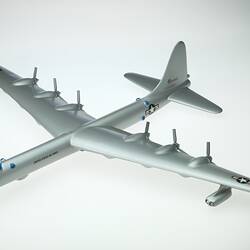Summary
Aircraft History
In the 1930s, the Seversky Aviation Corporation in the United States was among the first American aircraft companies to develop an all-metal monoplane, stressed-skin fighter aircraft for the United States Army Air Corps with the Seversky P-35. This was later developed into the P-43 Lancer with the installation of a turbocharged Pratt & Whitney R-1830 Twin Wasp engine. In 1939 the company's name was changed to the Republic Aviation Corporation. The P-43 had been placed in limited production in 1940-41 but a further development based on the more powerful Pratt & Whitney R-2800 Double Wasp engine showed more promise and was developed as the XP-47B. The design was ordered for production by the US Government as the P-47B in 1941. The massive size and technical complexity of the design caused delays in operational deployment but by 1943, the P-47 was in service with the United States Army Air Force (re-named in 1941) in Europe and the South-West Pacific Area which included Australia and New Guinea. The B, C and early D models had a cockpit canopy faired into the rear fuselage but later D, M and N models had a clear 'bubble' canopy with a cut-down rear fuselage. The 'Thunderbolt' was widely used by the Royal Air Force in Burma where it was flown by many Australian pilots. The USAAF Fifth Air Force operated it extensively in Australia and New Guinea. A large number of P-47's were assembled and test-flown at the Commonwealth Aircraft Corporation factory at Fisherman's Bend, Port Melbourne during World War II.
Model History
This model of a P-47N is mounted on a display stand and carries no unit markings. It was donated to the Museum in 1954 by Colonel John.L Sullivan. Colonel Sullivan was the Air Attache with the US Embassy in the early 1950s. It appears to be a presentation model made for promotional or display purposes. This model had apparently been loaned to the Museum for the 'Jubilee of Flight' exhibition in 1953-54.
More Information
-
Collecting Areas
-
Acquisition Information
Donation from Colonel J. L. Sullivan, 08 Feb 1954
-
Manufacturer of Item Modelled
Republic Aviation Corp., United States of America, Dec 1944 - Dec 1945
-
Classification
Air transport, Aircraft, Model propeller aircraft - military
-
Category
-
Discipline
-
Type of item
-
Keywords
Aeroplanes, Fighters, Military Aircraft, Model Aeroplanes, Scale Models, Wars & Conflicts




